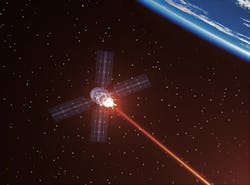Military researchers ask industry to develop wireless networks that use lasers to transmit electrical power
ARLINGTON, Va. – U.S. military researchers are asking industry to develop free-space laser power networks able to transmit electrical power over webs of lasers using aircraft as receivers and relays of optical energy.
Officials of the U.S. Defense Advanced research Projects Agency (DARPA) in Arlington, Va., issued a Small Business Innovation Research (SBIR) opportunity (HR001121S0007-29) on Thursday for the Breakthrough Technologies for Energy Web Dominance project.
A wireless network energy web that consists of several dynamic nodes will improve military capabilities significantly, DARPA researchers say. To achieve this, researchers are interested in three technology areas: high-energy-flux; high-efficiency optical energy conversion; and relay technologies.
The goal is to develop safe optical power-beaming web networks with links that provide rigorous photon containment and intrusion monitoring to ensure optical energy goes to the intended receiver without harming human bystanders or objects.
Related: Optical technology: at the speed of light
Such an energy web network consists of ground laser sources providing power to airborne nodes that use this power for own-ship requirements through conversion, and then relay the remaining power without conversion to other energy web nodes. Designs should support low size, weight, and power (SWAP) for the airborne portions of the power beaming system.
Traditional photovoltaic power beaming loses efficiency at high energy fluxes due to high temperatures, researchers explain. Although conversion methods such as thermoelectrics are one approach to achieving higher energy fluxes, they typically have poor efficiency.
The DARPA Breakthrough Technologies for Energy Web Dominance project seeks to optimize system efficiency by accounting for cooling losses for systems with an energy flux of 1 kilowatt per square meter, and scalable to 100 kilowatts per square meter or more.
Relays are elements of the optical chain that retransmit optical energy without first converting it back to electricity. These optical waveguides could be as simple as a mirror, but likely will involve several components to redirect power flexibly to intended receivers.
Related: Unmanned submarines seen as key to dominating the world’s oceans
Relays must demonstrate high efficiency and beam quality while accounting for losses such as fiber coupling inefficiencies and wavefront aberrations from turbulence in the propagation path. Proposals should address ways to correct beam aberrations or mitigate losses in optical chain relays.
Safety also is a big concern. Wireless beaming of optical energy will require at least 10 to 100 kilowatts of sustained beamed optical power. These power levels are inherently dangerous and pose substantial systems design challenges, particularly for dynamic platforms operating in real world environments.
Of particular concern is the danger to bystanders who may be subject to “splash” glints or “spillover” reflections that are inadvertently directed toward unintended locations.
DARPA researchers are looking for technologies that substantially address these safety concerns through rigorously assured photon containment. Low-SWAP solutions also must provide continuous path monitoring to detect and react to mobile intruders into the beam.
Any proposed method of assured photon containment may tackle a portion of the overall problem. One solution might involve sensing glints over a nearly spherical field of regard. Another might design surface morphologies that capture reflections, antireflective, coatings or absorptive surfaces.
Rigorously assured photon containment provides a probability of less than one in one billion likelihood of unintended radiation emission at irradiance levels exceeding 5 milliwatts per square centimeter that are capable of reaching human subjects if below wavelengths of 1.4 microns. If above 1.4 micron irradiance levels should not exceed 100 milliwatts per square centimeter.
Enabling technologies from this project aren't just for military applications. The systems required for efficient power beaming can be applied to many other applications such as free-space laser communications, high-energy laser propagation, LIDAR, or other high-pulse-energy or continuous power laser applications.
Optical systems with high tolerance for thermal loads also may be applied to systems that operate in challenging environments involving nearby sources of heat.
Related: Power supplies grapple with open systems, and the need for more power
Companies interested should upload full proposals to the DOD SBIR/STTR Proposal Submission website no later than 30 Nov. 2021 at www.sbir.gov/content/submission-proposals.
Email questions or concerns DARPA at [email protected], with BAA HR001121S0007-29 in the subject line.
More information is online at https://sam.gov/opp/64463b5ca4464cb291e82f2c928e87e8/view.
About the Author
John Keller
Editor-in-Chief
John Keller is the Editor-in-Chief, Military & Aerospace Electronics Magazine--provides extensive coverage and analysis of enabling electronics and optoelectronic technologies in military, space and commercial aviation applications. John has been a member of the Military & Aerospace Electronics staff since 1989 and chief editor since 1995.
